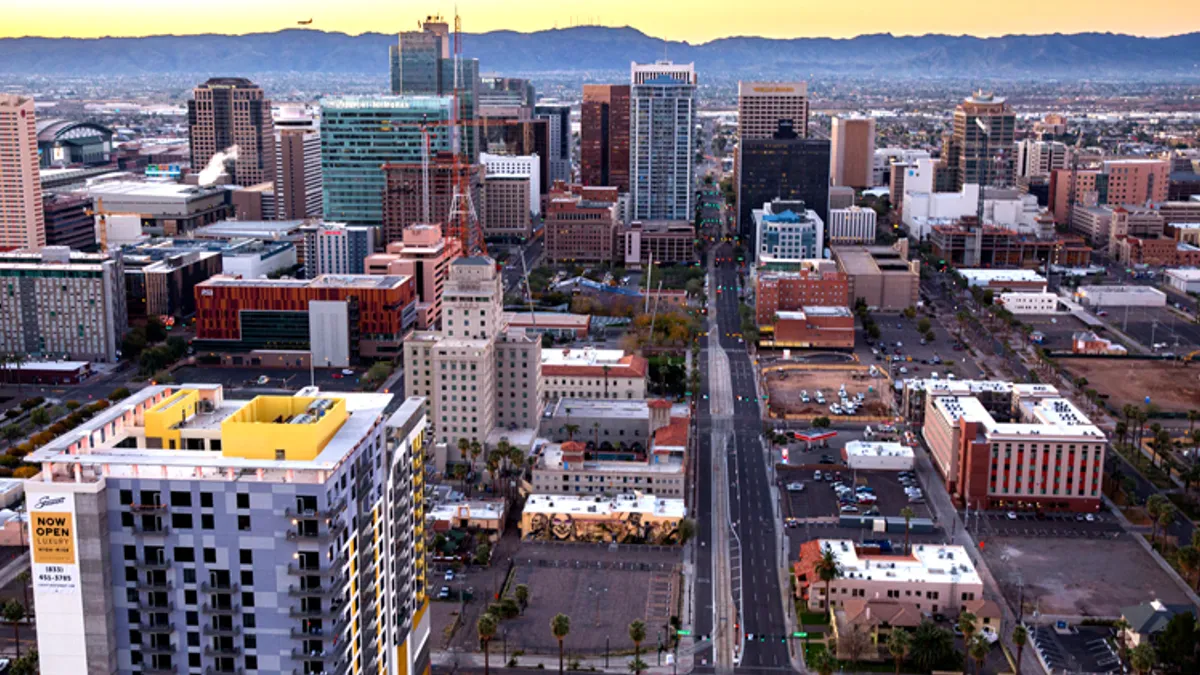Dive Brief:
- New Dodge Data & Analytics research shows that U.S. commercial and multifamily construction starts plunged 22% during the first six months of 2020 compared to the same time frame in 2019. In terms of sectors, only warehouse construction posted a very small gain, while office, retail, hotels, commercial garages and multifamily housing all fell.
- The data also showed that out of the country's major markets, only one — Phoenix — was spared from declines brought on by COVID-19. Combined, the country's top 10 largest metro areas for commercial and multifamily by dollar volume starts slid 21%.
- “The COVID-19 pandemic and recession have devastated most local construction markets,” said Richard Branch, Dodge chief economist, in a release. “Across the board, building projects have been halted or delayed with virtually no sector immune from damage."
Dive Insight:
A Dodge analysis of the largest markets for commercial and multifamily construction by dollar value shows the 10 biggest negative percentage changes in starts compared to last year:
| Market | First half 2019 | First half 2020 | % change |
|---|---|---|---|
| San Francisco | $2.9 bilion | $1.2 billion | -58% |
| Tampa | $2.1 billion | $929 million | -56% |
| Nashville | $2.6 billion | $1.2 billion | -54% |
| Washington, D.C. | $7.2 billion | $4.2 billion | -42% |
| Austin, Texas | $3.4 billion | $2.2 billion | -36% |
| Columbus, Ohio | $1.3 billion | $860 million | -34% |
| Philadelphia | $2.5 billion | $1.7 billion | -33% |
| Boston | $3.7 billion | $2.5 billion | -31% |
| Orlando | $1.7 billion | $1.2 billion | -27% |
| New York City | $15.2 billion | $11.5 billion | -24% |
Conversely, commercial and multifamily construction starts in Phoenix bucked the national trend, posting an 82% increase to $2.8 billion during the first half of 2020 relative to the same time frame in 2019. The increase was fueled by the start of some sizable projects, most notably the $300 million Pier 202 mixed-use building and the $125 million Adeline Residences at Collier Center, the $200 million 100 Mill Ave office development and the $115 million Park 303 warehouse building.
All of the country's top three markets by dollar volume posted declines in commercial and multifamily starts:
1. New York City metro area
$11.5 billion
Down 24%
New York City was tenth on list of worst performing major markets, despite the almost two-month ban on nonessential construction in the city. The modest impact on construction was due to the start of two very large office projects that broke ground in February — the $1.3 billion Two Manhattan West office building and the $760 million Disney/ABC Headquarters. Removing those two buildings would have resulted in a 50% decline in commercial starts during the first half of the year, according to Dodge.
2. Washington, D.C. metro area
$4.2 billion
Down 42%
Commercial starts fell 50% during the first half of the year, with the only gain coming from the hotel sector, which posted a $67 million gain while multifamily starts lost 27%. The largest commercial project to break ground in the Washington DC metro was the $306 million Aligned Energy Data Center (Building II) in Ashburn VA. Amazon Inc. also broke ground on two buildings associated with the HQ2 project in Arlington VA, each totaling $240 million.
3. Dallas metro area
$3.8 billion
Down 2%
Multifamily starts in the Dallas area gained 8%, one of the few top metros to post a gain in this market. The largest multifamily projects to get started in the first six months were the $75 million Novel Turtle Creek residential tower in Dallas TX and the $65 million Shannon Creek apartments in Burleson TX. Commercial starts fell 6%, with declines in hotel, office and parking structures partly offset by gains in retail and warehouse starts. The largest commercial projects were the $136 million Epic Deep Ellum (building II) in Dallas TX and the $100 million American Airlines flight kitchen.
Branch said he sees glimmers of hope in some of the country's hard-hit markets, which may lead to a modest recovery as the year progresses.
"However," he said, "the recent acceleration of COVID-19 cases in the South and West as well as the upcoming expiration of expanded unemployment insurance benefits (from the CARES Act) puts the recovery at significant risk and could undermine the construction sector’s ability to grow.”













